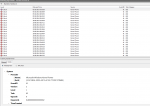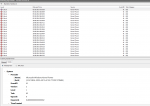Garry Newman
Member
First of all, the specs:
Case
FRACTAL DESIGN ARC MIDI R2 MID-TOWER CASE
Processor (CPU)
Intel® Core™i7 - 8 Core Processor Extreme i7-5960X (3.0GHz) 20MB Cache
Motherboard
ASUS® X99 DELUXE: ATX, HSW-E CPU, USB 3.0, SATA 6 GB/s
Memory (RAM)
64GB CRUCIAL DDR4 2133MHz (8 x 8GB)
Graphics Card
NONE, I ALREADY HAVE A GRAPHICS CARD
1st Hard Disk
1TB VELOCIRAPTOR WD1000DHTZ, SATA 6-Gb/s, 64MB CACHE (10,000rpm)
1st DVD/BLU-RAY Drive
24x DUAL LAYER DVD WRITER ±R/±RW/RAM
Power Supply
CORSAIR 1000W RM SERIES™ MODULAR 80 PLUS® GOLD, ULTRA QUIET (£139)
Processor Cooling
INTEL SOCKET LGA2011 STANDARD CPU COOLER
Thermal Paste
ARCTIC MX-4 EXTREME THERMAL CONDUCTIVITY COMPOUND (£9)
Sound Card
ONBOARD 8 CHANNEL (7.1) HIGH DEF AUDIO (AS STANDARD)
Wireless/Wired Networking
10/100/1000 GIGABIT LAN PORT (Wi-Fi NOT INCLUDED)
USB Options
MIN. 2 x USB 3.0 & 6 x USB 2.0 PORTS @ BACK PANEL + MIN. 2 FRONT PORTS
Power Cable
1 x 1 Metre UK Power Cable (Kettle Lead)
Operating System
Genuine Windows 7 Professional 64 Bit w/SP1 - inc DVD & Licence (£109)
Office Software
FREE 30 Day Trial of Microsoft® Office® 365
Anti-Virus
BULLGUARD INTERNET SECURITY - FREE 90 DAY TRIAL
Warranty
3 Year Standard Warranty (1 Month Collect & Return, 1 Year Parts, 3 Year Labour)
I've received my custom PC 2 weeks ago and for the last 3 days, my PC started to act up strangely. It started with freezes (weird headphone static sound and then freeze up) and eventually led to random reboots. I've checked my CPU and GPU temperatures and both of them are always below 34C (idle).
I have not overclocked or anything so I don't see how heat and overclocking has something to do with this.
Case
FRACTAL DESIGN ARC MIDI R2 MID-TOWER CASE
Processor (CPU)
Intel® Core™i7 - 8 Core Processor Extreme i7-5960X (3.0GHz) 20MB Cache
Motherboard
ASUS® X99 DELUXE: ATX, HSW-E CPU, USB 3.0, SATA 6 GB/s
Memory (RAM)
64GB CRUCIAL DDR4 2133MHz (8 x 8GB)
Graphics Card
NONE, I ALREADY HAVE A GRAPHICS CARD
1st Hard Disk
1TB VELOCIRAPTOR WD1000DHTZ, SATA 6-Gb/s, 64MB CACHE (10,000rpm)
1st DVD/BLU-RAY Drive
24x DUAL LAYER DVD WRITER ±R/±RW/RAM
Power Supply
CORSAIR 1000W RM SERIES™ MODULAR 80 PLUS® GOLD, ULTRA QUIET (£139)
Processor Cooling
INTEL SOCKET LGA2011 STANDARD CPU COOLER
Thermal Paste
ARCTIC MX-4 EXTREME THERMAL CONDUCTIVITY COMPOUND (£9)
Sound Card
ONBOARD 8 CHANNEL (7.1) HIGH DEF AUDIO (AS STANDARD)
Wireless/Wired Networking
10/100/1000 GIGABIT LAN PORT (Wi-Fi NOT INCLUDED)
USB Options
MIN. 2 x USB 3.0 & 6 x USB 2.0 PORTS @ BACK PANEL + MIN. 2 FRONT PORTS
Power Cable
1 x 1 Metre UK Power Cable (Kettle Lead)
Operating System
Genuine Windows 7 Professional 64 Bit w/SP1 - inc DVD & Licence (£109)
Office Software
FREE 30 Day Trial of Microsoft® Office® 365
Anti-Virus
BULLGUARD INTERNET SECURITY - FREE 90 DAY TRIAL
Warranty
3 Year Standard Warranty (1 Month Collect & Return, 1 Year Parts, 3 Year Labour)
I've received my custom PC 2 weeks ago and for the last 3 days, my PC started to act up strangely. It started with freezes (weird headphone static sound and then freeze up) and eventually led to random reboots. I've checked my CPU and GPU temperatures and both of them are always below 34C (idle).
I have not overclocked or anything so I don't see how heat and overclocking has something to do with this.
Last edited:


